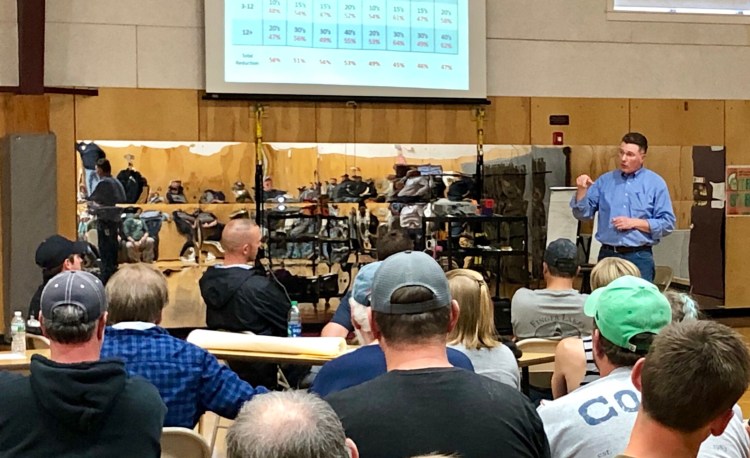TRENTON — In private conversations, local fishermen all tell David Horner, a longtime Southwest Harbor lobsterman, the same thing: they’d be willing to fish fewer traps to get the whale advocates off their backs, but not if their sacrifices are going to be exploited by other fishermen.
If the state wants to cut the number of traps each fisherman can set to reduce the number of buoy lines in the water, and protect right whales from entanglements, Maine can’t keep letting new lobstermen into the fishery or allow people in other territories to fish here, Horner said.
“Behind the scenes, they all say exactly the same thing,” Horner, the chairman of the local lobster zone council, said at a state hearing on new right whale protection regulations. “Fishermen could accept (a trap cut), I think, but not if we are going to have more people coming in to fill the gap, especially those from outside.”
The Maine Department of Marine Resources kicked off a monthly series of public information sessions on the new whale rules Tuesday. More than 100 lobstermen from the local zone, which runs from Franklin to Frenchboro, turned out.
Carroll Staples, a third-generation Swans Island lobsterman, agreed with Horner, saying that any kind of concessions made by existing lobstermen to reduce the number of buoy lines in the water to protect whales will help only if the state actually caps the number of people in the fishery.
“Don’t see how you can drop everybody in this room … and continue to print licenses,” Staples said. “You would have to at the same time cap the amount of tags we have so there is never another vertical line set. Or we’ll be right back here in 10 years with more vertical lines and split the pie up that much more.”
Many at Tuesday’s hearing remained resistant to the idea that the Maine lobster industry should have to give up anything at all to protect an endangered whale that few who have spent their lives working on the ocean have ever seen.
Signs protesting the federal mandate lined the road leading to the Trenton Elementary School, which hosted the meeting. “Save the whales, murder the fisherman,” read one pair. Another pair said: “Ship strikes kill whales, not Maine fisherman.”

Signs protesting the federal mandate lined the road leading to Trenton Elementary School, where Tuesday’s meeting was held. “Save the whales, murder the fisherman,” read one pair. Another pair said: “Ship strikes kill whales, not Maine fisherman.” Penelope Overton/Staff Writer
The Department of Marine Resources has until September to come up with a way that it can cut the number of buoy lines in the Gulf of Maine by 50 percent. Federal regulators say that’s what it will take to reduce the risk of fatal entanglement enough for the species to survive.
Scientists estimate only 411 right whales remain. The species has been on the brink of extinction before, most recently in 1992, when its population bottomed out at 295. It rebounded to about 500 in 2010, but low calving rates, ship strikes and fishing line entanglements have again sent its numbers tumbling.
But many in Maine’s $485 million lobster fishery worry it is the lobsterman who will face extinction if federal officials insist on such a deep cut in buoy lines, forcing the state to choose which kind of lobsterman will survive – small inshore operators or high-volume lobstermen who fish in deeper waters.
To reduce the number of vertical lines that could entangle a whale, the industry must decide if it would rather fish fewer traps overall, which could hurt bigger operators that rely on volume to meet their bottom line, or put more traps on each buoy line, which smaller operators say is dangerous for them.
At a meeting this month, Department of Marine Resources Commissioner Patrick Keliher said he thought Maine would have to submit a statewide plan to the National Marine Fisheries Service for approval, a sticking point in a state where every region tends to embrace its own method of fishing.
But on Tuesday, Keliher said he would consider proposing a plan that would allow individual fishing zones to come up with their own plans so long as they achieved the same reduction of buoy lines as the state plan, even though a localized plan might be harder to enforce, especially for those who fish on the edge of zones.
Send questions/comments to the editors.


